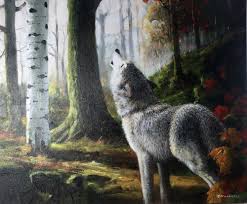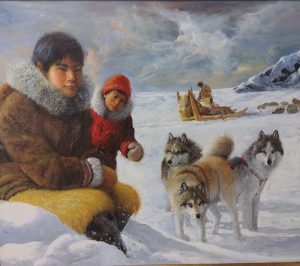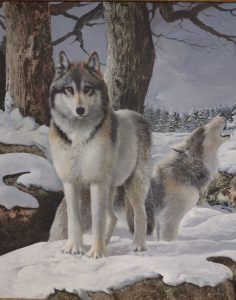Amneris Fernandez
BIOGRAPHY
Amneris Fernandez was born in Santa Apolonia, Venezuela, in 1950. The oldest of 10 children, Fernandez grew up on a family farm in the Andes. Though his family was poor, there was always sufficient food on the table.
When Fernandez was six years old, his mother noticed his artistic gift when she saw a remarkable drawing of Jesus drawn by Fernandez in the dry earth next to the coffee plants. Fernandez remembers this moment well. She instructed him not to erase the figure with his feet, but to use his hand instead.
Fernandez’s father wanted him to spend his life helping the family and working on the farm. Hehad hoped his son would become a farmer, like himself. But his mother, recognizing her son’s desire to explore his artistic gift and to live a different life, convinced his father to let him go. At the young age of 13 years old, Fernandez moved to Merida, Venezuela, to attend secondary school.
At the age of 18 years old he moved to Caracas, Venezuela where he worked for one year as an elevator operator. During idle moments he would draw while waiting for passengers. One day a gentleman, unknown to Fernandez, named Pascual Navarro – a Venezuelan arts master entered the elevator. Noticing Fernandez’s sketch, he requested to see it. Impressed by his gift, he invited Fernandez to explore and perfect his gift with him and later to teach in his Art Studio, where Fernandez’s artistic gift blossomed.
When Fernandez turned 19 years old his life became filled with activity. For a period of three years, his daily routine included morning work at the Air Force where he worked as a draftsman of aircraft, afternoon studies at the Venezuelan School of Fine Arts “Cristobal Rojas,” and evening studies at the School of Technology, where he studied electronics. Wishing to perfect his gift further and to learn the English language, in 1975 Fernandez moved to London, England, to attend “Saint Martin’s School of Fine Arts.”
In 1981, Fernandez returned to Venezuela. In 1985 he won first prize at the Annual Symposium of Fine Arts. At this time, and up until 1987, Amneris used to sign his paintings as “Annerys.” In 1983 Fernandez made his first visit to Canada to see a cousin. In 1988 he moved to Quebec. With him he brought his South American experiences, subject matters and colors, which were at odds with the Northern environment he now found himself in.
For a period of time, he lived in the uncomfortable state of doubt. However, local galleries recognized his artistic gift and encouraged him to paint subject matters and colors reflecting the North American experience. During his first year in Canada, Fernandez worked as a street artist in Old Montreal, where people from all over the world stopped to have their portraits painted (medium: pastel). This is a time Fernandez remembers fondly.
He also examined the indigenous peoples and animals of North America. As a result, his early work depicted the historical lives of Native North American Indians, the Inuit and the polar bear (medium: oil and acrylic on canvas or wood). His style was mostly realistic, however, also created surrealistic images of motion, human form, earth, water, fire and air. Up until 2005, Fernandez’s work in Canada consisted mostly of realism with an occasional surrealistic piece. Today, as he and his art evolve, he is blending the surrealistic with the realistic.
Education:
London, England Saint Martin School of Fine Arts
Caracas, Venezuela School of Fine Arts Cristobal Rojas
Prizes:
2004 Artist spotlight, PBS 2004 Arts Auction, United States
2003 First Place Award, PBS Arts Auction, USA
1985 First Prize, Annual Symposium of Fine Arts, Venezuela
BIOGRAPHIE
Amneris Fernandez est né à Santa Apolonia, au Venezuela, en 1950. Le plus ancien des 10 enfants, Fernandez a grandi sur une ferme familiale dans les Andes. Bien que sa famille fût pauvre, il y avait toujours suffisamment de nourriture sur la table.
Lorsque Fernandez avait six ans, sa mère a remarqué son talent artistique quand elle a vu un dessin remarquable de Jésus tiré par Fernandez dans la terre sèche à côté des plants de café. Fernandez se souvient de ce moment bien. Elle lui a demandé de ne pas effacer la figure avec ses pieds mais d’utiliser sa main à la place.
Le père de Fernandez voulait passer sa vie à aider la famille et le travail sur la ferme. Hehad espérait que son fils deviendrait un agriculteur comme lui. Mais sa mère, tout en reconnaissant le désir de son fils d’explorer son talent artistique et de vivre une vie différente, a convaincu son père de le laisser aller. À l’âge de 13 ans, Fernandez a déménagé à Mérida, au Venezuela, à l’école secondaire.
À l’âge de 18 ans, il s’installe à Caracas, au Venezuela, où il a travaillé pendant un an comme un opérateur d’ascenseur. Dans ses moments d’inactivité, il dessinait en attente de passagers. Un jour, un monsieur inconnu de Fernandez, nommé Pascual Navarro – un maître d’arts du Venezuela, est entré dans l’ascenseur. Remarquant le croquis de Fernandez, il a demandé de le voir. Impressionné par son talent, il a invité Fernandez à explorer et à perfectionner son don avec lui, et plus tard, à enseigner dans son studio d’art, où son don artistique sest épanouit.
Lorsque Fernandez eût 19 ans, sa vie fut remplie d’activités. Pendant une période de trois ans, son quotidien se résumait au travail du matin à l’Armée de l’Air où il a travaillé en tant que dessinateur d’avions et les études, l’après-midi, à l’école vénézuélienne des Beaux-Arts “Cristobal Rojas”, et le soir, les études à l’Ecole of Technology, où il a étudié l’électronique. Désirant parfaire son art et apprendre la langue anglaise, en 1975, Fernandez a déménagé à Londres, en Angleterre, ou il fréquenta “l’Ecole des Beaux-Arts de Saint-Martin.”
En 1981, Fernandez retourne au Venezuela. En 1985, il remporte le premier prix lors du Symposium annuel Des Beaux-Arts. À cette époque, et jusqu’à 1987, Amneris signait ses peintures “Annerys.”
En 1983, Fernandez a fait une visite au Canada pour voir un cousin. En 1988, il s’installe à Québec. Il apporta son expérience en Amérique du Sud, les matières et les couleurs, qui étaient en contradiction avec l’environnement du Nord, oùl se trouvait maintenant. Toutefois, les galeries locales ont reconnu son don artistique et l’ont encouragé à peindre des sujets et et couleurs réflétant l’expérience nord-américaine.
Au cours de sa première année au Canada, Fernandez a travaillé comme artiste de rue dans le Vieux-Montréal, où les gens de partout dans le monde s’arretaient pour avoir leurs portraits peints (moyenne: pastel). C’est un moment que Fernandez se souvient avec émotion.
Il a également examiné les peuples indigènes et les animaux d’Amérique du Nord. En conséquence, ses premiers travaux dépeingnaient la vie historique des Indiens d’Amérique du Nord, les Inuits et l’ours polaire (moyenne: huile et acrylique sur toile ou bois). Son style était surtout réaliste,mais il crée des images du mouvement surréaliste, forme humaine, la terre, l’eau, le feu et l’air.
Jusqu’en 2005, le travail de Fernandez au Canada se traduisait principalement de réalisme avec une pièce de surréalisme occasionnelle. Aujourd’hui, comme son art a évolué, il mélange le surréaliste et le réaliste.
Formation:
Londres, Angleterre École des Beaux-Arts Saint Martin
Caracas, Venezuela École des Beaux-Arts Cristobal Rojas
Prix:
2004 projecteurs de l’artiste, PBS 2004 Arts Auction, États-Unis
2003 Première place Award, PBS Arts Auction, USA
1985 Premier prix, Symposium annuel des Beaux-Arts, Venezuela



